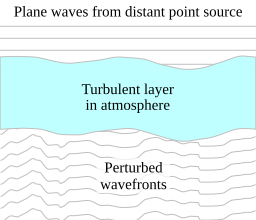
Back رؤية فلكية Arabic Seeing (astronomia) Catalan Seeing German Ατμοσφαιρική τύρβη (αστρονομία) Greek Seeing Spanish دید نجومی Persian Seeing Finnish Seeing French ראייה אסטרונומית HE Seeing Italian

In astronomy, seeing is the degradation of the image of an astronomical object due to turbulence in the atmosphere of Earth that may become visible as blurring, twinkling or variable distortion. The origin of this effect is rapidly changing variations of the optical refractive index along the light path from the object to the detector. Seeing is a major limitation to the angular resolution in astronomical observations with telescopes that would otherwise be limited through diffraction by the size of the telescope aperture. Today, many large scientific ground-based optical telescopes include adaptive optics to overcome seeing.
The strength of seeing is often characterized by the angular diameter of the long-exposure image of a star (seeing disk) or by the Fried parameter r0. The diameter of the seeing disk is the full width at half maximum of its optical intensity. An exposure time of several tens of milliseconds can be considered long in this context. The Fried parameter describes the size of an imaginary telescope aperture for which the diffraction limited angular resolution is equal to the resolution limited by seeing. Both the size of the seeing disc and the Fried parameter depend on the optical wavelength, but it is common to specify them for 500 nanometers. A seeing disk smaller than 0.4 arcseconds or a Fried parameter larger than 30 centimeters can be considered excellent seeing. The best conditions are typically found at high-altitude observatories on small islands, such as those at Mauna Kea or La Palma.